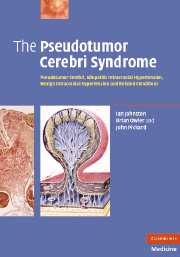 The Pseudotumor Cerebri Syndrome
The Pseudotumor Cerebri Syndrome Book contents
2 - History of the pseudotumor cerebri concept
Published online by Cambridge University Press: 21 August 2009
Summary
Introduction
The evolution of the pseudotumor cerebri concept has depended on a combination of precise clinical description and continuing technological advances in the methods used for investigation. Tracing the history of the concept is not only of intrinsic interest but also helps to clarify how our present ideas on disease mechanism, nomenclature, classification, and treatment, all areas of on-going contention, have been arrived at. It must be said, however, that while discussion of the history of ideas on the condition does undoubtedly provide insights into some of its fundamental aspects, it also has the somewhat sobering effect of bringing into focus how little progress has actually been made. For example, on mechanism, the idea of a disturbance of CSF circulation as being at the root of the condition was originally canvassed in the very early years before being discarded, but is now returning to favour. On aetiology, cranial venous outflow impairment, which featured so strongly in early accounts, has now re-surfaced as a major consideration. In treatment, optic nerve sheath decompression, which was initially advocated over 100 years ago before quickly being abandoned, has now returned to a position of prominence. In these three aspects the wheel has turned full circle.
In presenting this outline of history, the papers of Quincke (1893, 1897 (Figure 2.1)) and Nonne (1904, 1914 (Figure 2.2)) are taken as pivotal, signalling the start of attempts to define a specific clinical syndrome. These papers will be given relatively detailed consideration.
- Type
- Chapter
- Information
- The Pseudotumor Cerebri SyndromePseudotumor Cerebri, Idiopathic Intracranial Hypertension, Benign Intracranial Hypertension and Related Conditions, pp. 6 - 29Publisher: Cambridge University PressPrint publication year: 2007


